

 The South African
The South African
by Col P. M. J. McGregor, SM
As a founder member of the United Nations a decision was taken by the South African Government on 4 August 1950, to support the UN appeal and the following statement was issued after a Cabinet meeting: ‘The Government has decided that special efforts should be made to render military aid. This will be offered in the form of a fighter squadron with ground personnel. As members of the Permanent Force are liable for service only in South Africa, service in the Far East will be on a voluntary basis.’
The decision was taken to send No 2 Squadron, known as ‘The Flying Cheetahs’, to represent South Africa in the war. This squadron had been formed in the early days of the East African campaign in World War II and had a proud record in that theatre as well as in the Western Desert, Sicily and Italy. The task of forming the squadron for overseas service was given to Cmdt S. v. B. Theron, DSO, DFC, AFC, a veteran fighter pilot of World War II. A call for volunteers was made by the Director General of the Air Force, Brig J. T. Durrant, CB, DFC, and the response was overwhelming not only from members of the Permanent Force but from the Citizen Force and ex-members of the SAAF. It was decided that no aircraft or supporting technical equipment would be sent from South Africa, but that it would be purchased from the United States and made available to the squadron when it arrived in the Far East.
At this stage the war in Korea had gone badly for the UN and South Korean forces, and the US 8th Army had been swept down the Korean peninsula by the invading North Korean forces and had a tenuous hold on the Pusan perimeter at the extreme southern end of the peninsula. However, the UN retained command of the air and supplies and reinforcements were poured into the peninsula.
On 5 September, 49 officers and 157 other ranks reported for duty at AFB Waterkloof and the programme of medical examinations and injections commenced and administrative details were finalized. A small liaison staff under Cmdt J. D. Pretorius, AFC, left for Japan on 10 September and on 25 September the squadron left Pretoria by train for Durban from where they set sail for Japan aboard the MV Tjisadane, arriving in Yokohama on 5 November. During this period the fortunes of the UN forces in Korea had changed with dramatic suddenness following the landing by Gen MacArthur of the US X Corps at Inchon on 15 September. This posed a major threat to all North Korean forces in the Southern peninsula and resulted in their rapid withdrawal. The situation had changed so rapidly that the personnel of 2 Squadron wondered if the war would not be over before they got there.
On arrival in Japan the squadron left for Johnson Air Force Base, about 32 km outside Tokyo, where conversion training on to the F-51D Mustang was commenced. Flying clothing was issued to pilots and they received lectures on air tactics, navigation, maps and other related subjects, while ground personnel were becoming acquainted with the technical problems of servicing and maintaining the Mustangs.
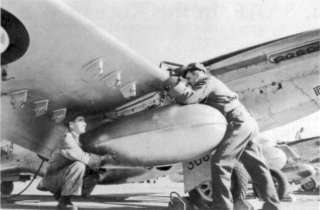
Installing a long-range tank
on F-51D no 308. This aircraft
was transferred to the SAAF
on 6 November 1950.
Note the aluminium painted surface
of the laminar flow wing
contrasting with the natural
metal finish of the fuselage.
The first operation carried out by the SAAF in Korea occurred on 19 November when Cmdt Theron and Capt Lipawsky took off from K-9 airfield to bomb and strafe Communist supply lines, the aircraft landing back at K-24 airfield at Pyong-yang in North Korea, to be followed later in the day by Capt J. F. O. Davis and Capt W. J. J. Badenhorst, both of whom were to be killed later in the war. The remainder of the detachment moved up from K-9 on 20 November and a South African unit commenced to operate from North Korean soil with the same fighting spirit and tenacity which it had shown in World War II.
The conditions at K-24 were somewhat primitive with the advance party living in tents in bitter winter conditions. No transport was available and all equipment had to be manhandled. The mess hall consisted of an old ex-North Korean Air Force hangar built of wood with gaping holes through which the freezing wind whistled fiercely, while the dirt floor was damp and cold. The one short runway was soft and rough, which made operating from it very difficult.
On 21 November a letter was received from the
Commanding General, Far East Air Force, Lt-Gen
George F. Stratemeyer which read as follows:
‘Dear Commandant Theron,
I noted with considerable satisfaction this morning
that your squadron was operational on 19 November
from its base at K-24 in Korea. I wish to congratulate
you on the expeditious manner in which your
squadron has become operational and take this
opportunity to wish you every success in your air
operations as a member of the United Nations team.'
At this stage the UN forces had crossed the 38th parallel and had reached the Yalu River, the border with Manchuria at several points, but it was obvious that the war in Korea had entered a new and ominous phase when UN troops started getting ambushed by so-called volunteers from Red China and on 26 November Chinese Communist forces started full-scale counter-attacks.

All ground transport and equipment
was provided by the USAF and
normally retained American insignia.
Here several vehicles are seen at
2 Squadron's base in 1953.
On 1 December the detachment at K-24 was given three days to get out of its base and move back to K-13 at Suwon, which it reached on 4 December. Back in Japan the last days of November had been filled with frustration and disappointment for the bulk of the squadron. Orders had come through for the squadron to move to K-24 on the 27th and all were keen to join their hard-pressed companions, but the move was postponed and then cancelled owing to the evacuation of K-24.
At K-13 the conditions were appalling. The countryside was completely covered in snow and tents were pitched on the snow-covered ground jwhich soon turned into mud inside the tents. Temperatures as low as -130C delayed flying in the early morning as the snow which had fallen during the night froze on the wing surfaces of the aircraft and had to be laboriously removed by hand before the aircraft could take off. The handful of pilots continued to attack enemy troops, trucks and supplies at every opportunity, but at this stage the detachment had only 6 aircraft, 11 pilots and 20 ground crew in Korea.
On 5 December the detachment lost its first aircraft when rockets fired by Capt Davis struck a railway truck loaded with explosives which blew up with a terrific explosion and Capt Davis was temporarily knocked unconscious. His aircraft had been severely damaged and he was forced to crash land it. His no 2, Capt Lipawsky, covered him and called for rescue services. A US L5 aircraft arrived at the scene and the pilot made a skilful landing on a narrow road adjacent to the downed aircraft and the observer, Capt Millet, gave up his seat to Capt Davis. This was an outstanding act of bravery as the area was surrounded by enemy troops and when the L5 later returned to the scene Capt Millet had disappeared and no trace of him could be found. Capt Lawrence later returned to the area and just before darkness found and picked up Capt Millet.
On 10 December five more pilots and their aircraft left Japan to join the detachment in Korea as well as 18 other ranks who were immediately employed in assisting the already worn-out ground crews there who had had to endure much more than was originally expected of them. On 12 December a maximum effort was made when four missions, comprising 16 sorties, were flown and in spite of low cloud and drizzling rain the detachment continued to provide close support for the hard-pressed ground forces by attacking rolling stock, supplies and troops.
The news was now received that the squadron detachment was to move back to K-10 at Chinae, only 48 km from K-9 where it had originally started. This airfield was situated on the edge of a small bay and nearby mountains provided a hazard to flying in the bad weather conditions which so often prevailed. However, it was a great improvement on the mud and cold of K-24 and K-13. On 17 December the remainder of the squadron moved across to K-10 and on 4 January 1951 the detachment at K-13 also moved back to K-10, so the whole squadron was together at last at a base which they were to occupy for over two years until they were re-equipped with F-86F Sabre aircraft in January 1953.
The FEAF now launched an intensive air assault designed to slow the advance of the Chinese Communist armies by disrupting their supply lines and making direct attacks on troops, transport, tanks and supply dumps. During December 2 Squadron carried out a large number of armed reconnaissance and interdiction missions with considerable success. At this stage the Chinese Communist armies were massed along the 38th parallel, the US 8th Army having retreated some 320 km to Seoul.
On 31 December the Communists launched a nine-division main thrust southward across the Imjin River against Seoul and UN forces were forced to fall back to the southern bank of the frozen Han River. On 6 January 1951, they abandoned Seoul to take up pre-arranged defensive positions from Pyongtack, through Wonju to the East Coast. During this period the enemy were subjected to repeated air attacks, despite low clouds with rain and snow storms. It was not an uncommon sight to see torch lights around aircraft parked on the flight line late at night as fitters, riggers and electricians were feverishly engaged in checking each aircraft for the next day’s operations, while the armourers loaded the machine guns and bombed up and fitted rockets to the aircraft scheduled for the first mission next morning.
Suspected areas of enemy activity were thoroughly inspected by Mustangs operating in pairs with one aircraft flying at 30 to 100 metres checking every building, haystack, ravine, wooded area, road and railway, while the other flew at about 300 metres to provide top cover. The result of these searching missions was that pilots were subjected to an increasing amount of ground fire as the Communists fought back and losses started rising. On 2 February Lt W. F. Wilson was hit by small arms fire and baled out over the sea only to disappear, while on 7 February 2/Lt D. R. Leah was killed when his aircraft was seen to strike the ground while staffing enemy vehicles on the road south of Yonhung. On 15 February Lt Doveton’s aircraft was shot down by ground fire while he was strafing enemy positions in the Kaesong area and he was killed. On 27 February the outstanding work which had been carried out by the squadron under the most difficult conditions was acknowledged when Cmdt S. v. B. Theron and Capts J. F. O. Davis, H. O. M. Odendaal, G. B. Lipawsky and W. J. J. Badenhorst were awarded American Distinguished Flying Crosses.
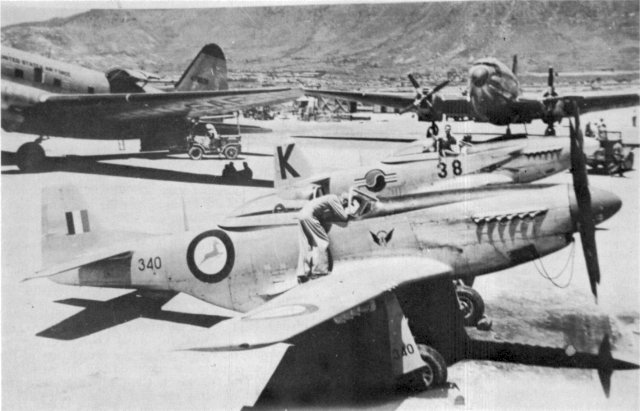
Lt H. Joyce's F-51D 340 (ex USAF 44-74757)
with an F-51D (no 38)of the Republic of Korea Air Force.
Note the Curtiss C-46s behind; this type was one
of the standard USAF transport aircraft in Korea.
In mid-March it was decided to lay pierced steel plating (PSP) on the sod runway at K-10, as torrential rains were seasonal in South Korea during the mid-summer months. While the resurfacing of the runway took place the squadron was moved to K-9 airfield. On 16 March Capt Lipawsky had the distinction of being the first 2 Squadron pilot to complete a tour of operations in Korea and he left for South Africa to be followed, the next day by Cmdt Theron who had handed over command of the squadron to Cmdt R. F Armstrong. The squadron had now established itself as a unit of the U N forces in Korea, had weathered a severe winter, had been efficiently integrated into 18 Fighter Bomber Wing of the USAF and had built up a reputation for operational skill and aggressiveness.
New faces appeared in the squadron as replacements started arriving, one of whom was Lt Mickey Rorke who decided that the squadron should have its own officers’ club so he set it up initially in a tent and later in a portion of the pilots' crew room. This appropriately became known as 'Rorke's Inn', becomng famous in Korea and perpetuated the memory of its founder after his untimely death in a flying accident at K-16.
Pilots on recce missions reported that the Communists were feverishly filling in bomb craters in the roads to enable heavy vehicles to move towards the front at night. It also appeared that forward airstrips were being repaired by the enemy for possible use by them and so instructions were issued to disperse aircraft on UN bases. Rain, mud and the wet climate now started to hinder operations and made living conditions unpleasant. During April the majority of SAAF missions were designed to locate and destroy enemy troops, vehicles and supplies using napalm bombs, rockets and machine guns, while 500 lb (227 kg) bombs were used against road and rail systems.
The SAAF continued to increase its efforts and a letter of appreciation was received from Lt-Gen George E. Stratemeyer, the Commanding General, Far East Air Forces, which stated: ‘On 12 April 1951, just two months after flying its 1000 sorties, No 2 Squadron SAAF completed 2000 sorties in support of UN forces in Korea. This continuing high rate is most noteworthy. I wish to express my sincere appreciation to the personnel of No 2 Squadron who have contributed to this commendable effort’.
The Commanding General of the Fifth Air Force, Lt-Gen Earle E. Partridge, added his endorsement to that letter by saying: ‘The above compliments of the Commanding General, Far East Air Forces, carry the enthusiastic endorsement of this headquarters. The enviable combat record of the 2nd South African Air Force Squadron in the Korean War is a splendid tribute to the fighting spirit of the freedom-loving people of your nation. My congratulations to you and the members of your command for the outstanding performance demonstrated. The aerial achievements of your organisation have reflected great credit upon yourself and the United Nations.’
On 22 April the Communists launched another major offensive employing some 70 divisions and UN forces were forced to withdraw in some sectors in the face of this massive onslaught. However, the air force rendered sterling service by strafing and attacking any troops seen, such as the 6000 who attempted to cross the Han River. Within 2 Squadron flights were allocated certain specific areas so that they could become thoroughly acquainted with them and their potential for the concealment of enemy vehicles or supply dumps.
On 23 April the squadron moved back to K-10 where the relaying of the runway with PSP had been completed. Considerable improvements had also been made to the base in the form of new mess halls, new hutments and ablution blocks and the resurfacing of roads. By 27 April the Communist offensive had petered out at a cost of some 70 000 casualties. Communist vehicle sightings during the first week of May indicated that the enemy was making supreme efforts to alleviate his logistical supply problems and, to provide the necessary protection for their vehicles, they had significantly increased their flak batteries. Intelligence plotted the location of 252 guns and 673 light anti-aircraft guns, including truck-towed Soviet 37 mm M-1939 automatic guns.
As there was an increase in enemy air activity from North Korean airfields the Rearmament and Refuelling Detachment, which had been at K-13, was moved on 7 May to K-16, the airfield at Seoul. On 9 May the biggest single air strike to date of the Korean War took place when 4 wings, comprising some 300 aircraft, attacked the Communist air base at Sinuiju in ‘Operation Buster’. Sixteen aircraft led by Maj Blaauw carried out close escort of surface vessels and rescue flying boats that were standing by for emergency landings and ditchings.
Maj Blaauw was involved in another incident on 11 May for which he was awarded the American Silver Star decoration. While four aircraft were on an interdiction mission 11 km west of Singe, the leader’s aircraft was hit by ground fire and the wing collapsed. Lt V. R. Kruger successfully baled out but dislocated his right shoulder and had several second degree burns when he landed. Two of the other members of the flight, Maj Blaauw and Lt Mentz, capped the downed pilot while Capt Clulow tried without success to alert the rescue organisation. Shortage of fuel compelled Lt Mentz and Capt Clulow to return to K-16 but Maj Blaauw, in spite of fuel shortage, continued capping operations and when his aircraft ran out of fuel he crash-landed it next to Lt Kruger, sustaining abrasions and bruises to his nose and eyes. He immediately went to the assistance of Lt Kruger and at 19h15 a helicopter arrived and rescued them both.
As from 12 May it was decided to carry out staggered operations from K-16 with 8 aircraft and so 27 ground crew were kept there to make this possible. Shortly after this, on 22 May, the Communist offensive collapsed and UN forces launched a counter-offensive. By the end of May they had again advanced to the 38th parallel and early in June the 8th US Army was in full possession of all South Korean soil except an area around Kaesong on the western front.
At the beginning of June it was decided that the primary responsibility of the air force would be the interdiction of enemy lines of communication and so an operation called ‘Strangle’ commenced in which railway bridges and tunnels and road bottlenecks were subjected to intense attack. In armed recce missions 2 Squadron now changed its tactics with the flight leader flying at low level looking for targets of opportunity, while the other three members of his flight remained higher up looking out for flak and enemy fighters.
On 24 June Lt G. H. Marshall put up a noteworthy exhibition when he led a flight of four Mustangs against a concentration of enemy troops situated in a practically inaccessible location. The surrounding terrain was defended by numerous enemy automatic weapons and heavy anti-aircraft guns. Without hesitation and with complete disregard for personal safety, Lt Marshall led his flight through the screen of intense and accurate enemy fire to deliver repeated attacks on the target, resulting in the destruction of five 40 mm guns, two automatic weapon positions and 150 enemy troops. An American marine, who had been involved subsequently wrote: ‘I’ll ever recall with minute detail the most spectacular feat I’ve ever lived to witness - and tell about. We had gained the ridgeline of our objective upon which we were catching all hell because of an overwhelming ‘Gook’ (Korean) counter-attack. The tide of battle was leaving casualties in its wake like seashells cast upon a beach. It was then we saw four silvery streaks plummet from the skies with guns blazing. It was so wondrous a sight we completely forgot our whereabouts or line and just stood up in our foxholes and cheered. The “Hall of Fame” does not possess any greater men than those who flew that day’. Lt Marshall was granted the immediate award of the US DFC for his outstanding gallantry and leadership, while the other members of his flight were awarded the US Air Medal.
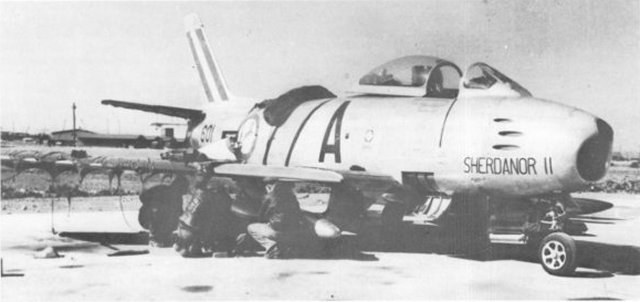
Cmdt Gerneke'e aircraft no. 601
(ex USAF 52-4352) was named 'Sherdanor II'.
It later carried the name 'Renkins'.
It was a sad day for the squadron when three out of four pilots in one flight were reported missing on 23 July. The weather was bad - solid overcast, with ceiling varying from 200 to 400 metres above ground level. After successfully attacking and destroying a bridge, the flight was returning in formation when the Mustang piloted by Capt Bekker was hit by ground fire, burst into flames and crashed into the ground. Approximately one minute later 2/Lt Halley’s aircraft was also hit and he baled out successfully. While Lt du Plooy remained over the area to provide cover for the downed pilot, Lt Green ascended to establish better contact with the rescue operation. Despite intensive ground fire, Lt du Plooy prevented enemy troops from capturing 2/Lt Halley until finally his ammunition was exhausted and the enemy closed in on the downed pilot. No further transmissions were heard from Lt du Plooy, but Lt Green sighted the wreckage of another smoldering aircraft, and subsequently he was presumed killed. He was posthumously awarded the American Silver Star for his outstanding bravery and determination in attempting to protect a comrade from capture in the face of intense and accurate enemy ground fire.
On 18 August the UN air forces launched a major offensive against rail and road communications in Korea to prevent the build-up of enemy forces and 2 Squadron was fully involved in this task. On 25 September it flew its highest number of sorties in any one day since arriving in Korea, namely 40. During its first year of operations the squadron had carried out 4920 sorties and had lost 36 out of6l aircraft acquired. It had destroyed over 2000 buildings, 458 vehicles, 173 rolling stock, 159 supply dumps, 83 anti-aircraft posts, 24 field guns, 14 tanks, 13 railway bridges and 1634 enemy troops.
On 22 September the R and R Detachment was moved from K-16, where rebuilding operations were to be carried out, to K-46 at Hoengsang. During October North Korea’s railways were destroyed faster than they could be repaired, while during November and December close support missions were carried out concurrently with rail interdiction operations.
At K-10 Maj Blaauw had been promoted to Cmdt and had taken over the squadron on 26 July. He in turn handed the squadron over to Cmdt B. A. A. Wiggett on 26 September. A tribute to the squadron’s ground personnel was received in a letter from Messrs Wright Patterson, Ohio, which stated: ‘The scope of the engine maintenance work performed by the SAAF reflects complete knowledge of the Packard Rolls-Royce engine and is commendable.’
During the early part of 1952 the increase in Communist flak along certain stretches of the North Korean railway resulted in attacks being shifted to other parts where there was less flak. Winter had now set in again and it was found that on some occasions the ground was frozen so hard that when making low level attacks the bombs skipped off the ground and exploded in the air, resulting in aircraft at times being damaged by their own bomb blasts.
On 20 March 1952, the squadron had its second brush with Migs when a flight of four Mustangs was attacked by five Migs. Lt Taylor’s aircraft was hit and he was forced to bale out, but one of the Migs was hit in the starboard wing by a long burst fired by Lt Enslin and it broke off the engagement and headed back towards the Yalu River.
Interdiction attacks continued during April and May but by now the Communists had emplaced flak batteries along nearly all their railway lines and there were virtually no flak-free targets to be found. They also had developed a highly efficient repair organisation which repaired rail cuts in 2 to 6 hours and bridges in 4 to 7 days. It was then decided that to put skilled pilots with expensive aircraft against unskilled labourers armed with picks and shovels was not cost effective. As the Panmunjom truce negotiations were approaching a complete impasse it was decided to put increased pressure on the North Korean negotiators by switching air attacks to the North Korean hydro-electric power complex.
On the afternoon of 23 June massive attacks were made against these targets, which included a formation from 2 Squadron led by Cmdt Burgher, who was now OC of the squadron. These attacks met with outstanding success and were followed up with further successful attacks. It was then decided that, to increase the pressure on the Communists at the truce talks, selected industrial targets should be attacked and so on 11 July intensive attacks were launched against 30 industrial targets in Pyongyang, to be followed by attacks on other industrial targets.
The time had now come for the squadron to bid farewell to its trusty Mustangs for in November the news was received that the squadron was going to be re-equipped with the F-86F Sabre jet aircraft. On 2 November 21 ground personnel commenced familiarisation courses at Tsuiki in Japan, and a week later one officer and 16 other ranks also left for Tsuiki, followed on 27 November by 4 other ranks. 2 Squadron flew its last operational sorties with Mustangs on 27 December and then moved to a new airfield at K-55 which was still under construction at Osan, 65 km south of Seoul.
On 28 January 1953, the SAAF received its first three Sabres and on 31 January the OC, Cmdt Gernecke, and second-in-command, Maj Wells, became the first SAAF pilots to fly Sabres and were most impressed by their performance. During February pilot training on these aircraft continued and on 12 March the squadron restarted its operational tour when four missions to the Yalu River, known as ‘Mig Alley’, were carried out.
Dive-bombing training was commenced in April and it was found that the Sabre was an excellent, stable dive-bombing platform. It was possible to carry two 1000 lb (454 kg) bombs plus drop tanks, which gave the aircraft an effective striking range. It was also suitable for carrying napalm or rockets and the squadron was soon employed in the ground attack role.
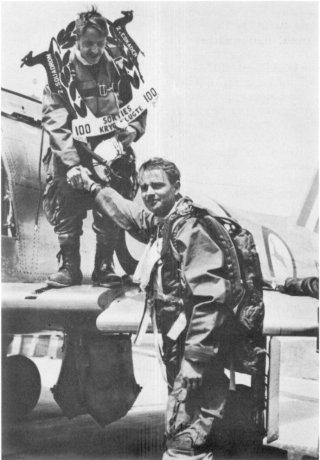
Congratulations to Capt E. Pienaar
from 2 Squadron's OC, Cmdt Gerneke,
on completing his 100th sortie.
The aircraft is an F-86F-30-NA Sabre
no 605 (ex USAF 52-4313).
On 27 July an armistice was signed, which was to be effective as from 22h01 on that day and in a final gesture 2 Squadron put up a record total of 41 sorties that day to bring their overall total for the war to 12 067 sorties of which 10 373 had been flown on Mustangs and 1694 on Sabres. The cost had been high as 74 out of 95 Mustangs had been lost as well as 4 Sabres, while a fifth was lost after the armistice when Lt Botha experienced both normal and alternative hydraulic-system failures and baled out over the sea, but was never recovered. The price in lives was also high as altogether 34 pilots and two ground crew paid the supreme sacrifice, while a total of 8 prisoners of war were returned by the Communists.
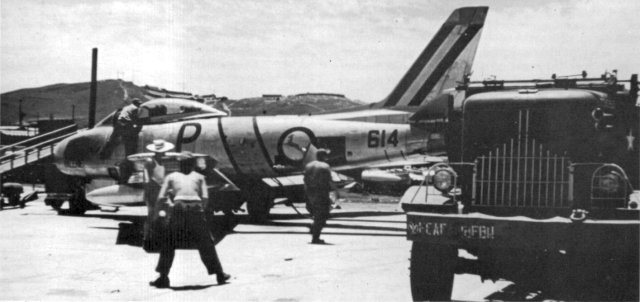
Preparing 614 'P' (ex USAF 52-4355 'Valerie')
for flight. This aircraft was written off
after being flown by Lt M.C. Botha on 28 August 1953.
So ended another saga in the history of the SAAF when one of its squadrons, operating far from its shores, fought with distinction and courage in the true tradition of the air force. The squadron was awarded both the United States and Republic of Korea Presidential Unit Citations for gallantry and exceptional determination against the enemy while its members were awarded two Silver Stars, 55 Distinguished Flying Crosses, one Soldier’s Medal, 42 Bronze Stars, 174 Air Medals and 152 clusters to the Air Medal.
A measure of the high regard in which the ‘Flying Cheetahs’ were held came as the last of them were about to embark for home, when the Commander of the 18th Fighter Bomber Wing issued a Policy Order which stated: ‘In memory of our gallant South African Comrades, it is hereby established as a new policy that at all Retreat Ceremonies held by this Wing, the playing of our National Anthem shall be preceded by playing the introductory bars of the South African National Anthem, “Die Stem van Suid-Afrika”. All personnel of this Wing will render the same honours to this anthem as our own.’
So ended another chapter in the memorable history of the SAAF.
Bibliography
History of United Nations Forces in Korea, Vol I. Ministry of
National Defence, Republic of Korea.
SAAF Official records. (Unpublished.)
Return to Journal Index OR Society's Home page
South African Military History Society / scribe@samilitaryhistory.org